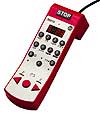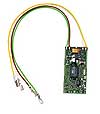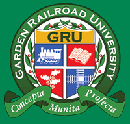

|

|
Power, Sound, R/C
:
Remote Control
An Introduction to DCC - Part 4
Feb 7, 2002


By Fred Hughes |
Author
Bio
Installing DCC in our garden can be as simple as connecting the base DCC system power leads to the rails and fitting an engine with a "mobile" decoder.
|
At first blush we may not experience any difference in controlling the train from the "Old Fashioned DC Transformer" days. With our hand throttle we will select the number of our engine and then, twisting a knob, or using a digital keypad, we start the engine down the track. The difference starts when we want to have another engine on the same section of track move independent of the first. With DCC we select the second engine with our hand throttle and issue the command. Now we start to appreciate the DIFFERENCE.
Installing an Engine Decoder
How difficult is it to install "mobile" decoders in our engines?
To install a decoder in a locomotive the motor/motors must be totally isolated from any other electrical components. Then the decoder is connected to the motor/motors with 2 wires and to the track pickups with 2 additional wires.
DCC is becoming so popular that many manufacturers are making their engines "Decoder Ready".
What does "Decoder ready" mean?

LGB 55015
Universal Remote
| LGB has been building "Decoder Ready" engines for several years. For LGB, "Decoder Ready" means that their locomotives with a "D" molded on the underside of the gearboxes are already wired so that the motors are isolated to allow for installation of a decoder. In fact they have been doing this so long that they have different versions. |
A "D" and a round "Direct Decoder" sticker on the gear case means that these units have a factory installed mounting socket that accommodates the LGB MTS decoder. "D" units with a round 6-dot sticker have been provided with an easily accessible 4 pin connecting point.
Installation of decoders in these engines is relatively easy but even their oldest units can be decoder equipped by "do-it-yourself" installation if one has a reasonable degree of electrical and mechanical ability. This does NOT apply to LGB engines with factory installed sound systems. For these locomotives you are limited to using the LGB MTS decoders unless you are a highly skilled electronic expert.
The reason for this is that the LGB sound systems use a proprietary method to trigger functions for activating the whistle, bell, sound on, sound off and other features. For these engines it is recommended that you have LGB install their decoders. This can be done for a reasonable fee and then the engines will operate on any DCC layout.
Several other G-Scale manufacturers are shipping their products "Decoder Ready." We need to check each engine individually because just like LGB some models are decoder ready and some not.

LGB 55021
MTS Loco Decoder II | The basic decoder for a G-Scale locomotive is a circuit board approximately 1 x 2 x 1/4 inches. Most engines will require only one decoder depending on the number of amps drawn by the motors, lights and the accessories. In some cases such as in selected USA Trains Diesel units, separate decoders might be required for each motor. |
Depending on the decoder we can control a number of different functions in addition to the motor. Other features can be wired to, and controlled by the same or separate decoders.
The basic options in all decoders include the ability to store and change values known as "Configuration Variables" CV's that allow the engineer to determine how the locomotive operates.
CV's are numbered using standard locations for certain operations. The following table shows some of the basic CV's and their use.
| # | FUNCTION | | CV 2 | STARTING VOLTAGE | | CV 1 | ENGINE NUMBER | | CV 3 | ACCELERATION MOMENTUM | | CV 4 | BRAKING MOMENTUM | | CV29 | RELATIVE DIRECTION
NUMBER OF SPEED STEPS
USAGE ON DC LAYOUTS |
Basic decoders have the above functions. Advanced decoders have many more. Options include wiring connections for as many as 12 additional functions. Connections for headlights and the ability to have them controlled automatically or by our hand throttle, the same for reverse lights, cab lights, smoke generators. CV's settings will allow us to adjust special effects depending on the model decoder. This includes output for Gyrolight, Mars light, Single Strobe, Double Strobe, Ditch Light, Blinking, Dimming. Blinking frequency can be controlled. For consists we can set the "Normal" direction of travel for any engine to be "backward".
Some decoders include "Back EMF" (Electro-motive-force) for the engine motors. This feature is like the cruise control in our cars and is very useful if our garden railroad has grades that will cause our trains to speed-up downgrade and slow to a crawl upgrade unless WE adjust the throttle. When "EMF" is ON the trains will maintain a constant speed.
If we wish to stage "Consists" on our layout advanced decoders allow us to assign 2 or more engines to the same "consist" address and control them as one unit. Sometimes this can be a problem if two locomotives have different style motors or gear ratios. If this condition exists the engines may actually work against one another and damage motors or gearboxes.

Lenz LE/LF200
Wiring Circuit
Click for larger picture | Advanced decoders allow the engineer to match locomotives so that when two engines are sent the same speed command they ACTUALLY run at the same speed. This is accomplished by adjusting "Speed Curves" that can be stored in each locomotive decoder. |
Decoders in rolling stock
DCC allows many additional options for unique features in the garden. One of these is the ability to install decoders in things other than engines.
Several DCC manufacturers offer "Mobile Accessory Decoders" that give us the chance to expand our horizons. One decoder in a caboose can be used to perform several different functions, turn on lights, interior lights, turn on a smoke generator for the stove or turn on outside lanterns.
We may wish to install a sound system in a boxcar so that we may use it with many different engines. A "Mobile Accessory Decoder" will allow us to do this and yet re-assign the controlling address to any engine.
Controlling lights in passenger cars and any other application is easily accomplished with the "Mobile Accessory Decoder". All these features will have constant power for lighting or operation.
Wiring the Track
A DCC layout is of course track powered and this means that good electrical conductivity is important to smooth operation. As mentioned previously DCC is alternating pulsed current, which will minimize electrolysis but we will still need to keep the track reasonably clean. LGB's track cleaner locomotive is the ultimate solution but not vital. Other track cleaning units can provide satisfactory results.

Hillman's RailClamps | Secure connections to insure electrical conductivity of the rails is very important. The easiest solution is using flexrail in 5 or 7 foot sections connected with rain clamps that are available from Hillman's RailClamps, or other sources. |
If we don't want to invest in rail clamps then soldered jumpers need to be installed between each rail section. If any of these methods are used one power feed connection is probably good for each 200 feet of track. If we have reverse loops then an automatic device, (available from several sources) must be installed to handle this condition. These units are connected directly to track power. No separate power needed and the unit can be installed in the garden (some weatherproofing required).
Turnout Wiring is Simple
Turnout decoders are available from most DCC manufacturers that will allow us to throw turnouts with our hand throttle. LGB and Lenz supply units specifically designed to power LGB turnouts in the garden. These units are operated by hand throttle and weatherproof. They require only direct connection to track power to operate. Other manufacturers offer units that can be controlled by both track triggers and hand throttle.
Accessory decoders can be connected directly to the track at any point on the layout, without separate wiring, to power signal lights, crossing guards, and scenery features such as smoke generators in buildings, street lights, bill boards action or sound features etc.
How many devices can be connected?

DCC BitSwitch
Click for larger picture | For practical purposes we are almost unlimited. As we add more loads we will reach the maximum allowed amps for the installed power booster. A protective circuit shuts down the power booster. Additional power boosters can be added as needed. |
Now that we have created a dream layout with many features and multiple trains how are we ever going to control the layout?
Next time: Multiple Operators and Automatic Operation.
Top of Page
|
|

|
IMPORTANT LINKS

Get Your Official Diploma

Watch New Videos


New Products Online
|
|



